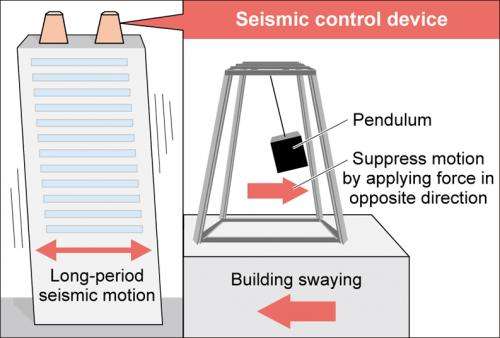(Phys.org) —Two Japanese companies, Mitsui Fudosan and Kajima Corp, have announced plans to install quake damping pendulums atop the Shinjuku Mitsui Building in downtown Tokyo by 2015. The building, like many others in the city, was built before new quake dampening technology was developed for skyscrapers.
Both old and new anti-quake technology is based on the same idea—heavy pendulums that counter the ground moving action caused by an earthquake. When an earthquake (with long-period seismic motion) begins, it pushes the base of a tall building in the direction of the seismic activity—the top of the building is left motionless for a moment, but then soon catches up, but by then, the bottom has moved back in the opposite direction. Such motions can cause tall buildings to sway violently resulting in damage or even destruction of the building. To counter such motion in newly built skyscrapers, pendulums are installed on the upper floors. They work by automatically swaying counter to the motion created by the earthquake. The result is a reduction in swaying and hopefully, damage to the building and harm to its occupants.
Unfortunately, many of Tokyo's skyscrapers were built long before the new pendulum technology was developed, leaving them at risk when the next quake strikes. In this new effort, engineers working for the two involved companies have devised a means for adding pendulums to the tops of existing skyscrapers. The 55 story Shinjuku Mitsui Building (which was observed to sway approximately 2 meters during the 2009 Great East Japan Earthquake of 2009) will be outfitted with six such pendulums, each hung inside its own frame and weighing 300 tons. Presumably, the size of the pendulums and the number would vary by building based on its size and space available on its top. Also, a thorough analysis of the building would have to be undertaken before adding so much weight—most buildings would likely require reinforcement. Adding the pendulums to the Shinjuku Mitsui Building is expected to cost approximately $51 million.
In Japanese.
Officials for the companies involved told the press at an announcement of the project that they believe the pendulums will reduce the amount of swaying by 60 percent and that they should also reduce the amount of time the building sways.
© 2013 Phys.org




















